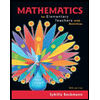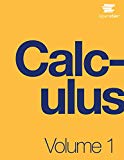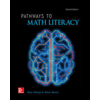
Each of Problems 1 through 5 can be interpreted as describing the interaction of two species with population densities
a) Draw a direction field and describe how solutions seem to behave.
b) Find the critical points.
c) For each critical point, find the corresponding linearsystem. Find the eigenvalues and eigenvectors of the linear system. Classify each critical point as to type, anddetermine whether it is asymptotically stable, stable, orunstable.
d) Sketch the trajectories in the neighborhood of each critical point.
e) Draw a phase portrait for the system.
f) Determine the limiting behavior of
Want to see the full answer?
Check out a sample textbook solution
Chapter 7 Solutions
Differential Equations: An Introduction to Modern Methods and Applications
Additional Math Textbook Solutions
Mathematics with Applications In the Management, Natural, and Social Sciences (12th Edition)
A Survey of Mathematics with Applications (10th Edition) - Standalone book
Finite Mathematics for Business, Economics, Life Sciences and Social Sciences
Mathematics with Applications In the Management, Natural and Social Sciences (11th Edition)
Fundamentals of Differential Equations and Boundary Value Problems
Mathematical Ideas (13th Edition) - Standalone book
 Discrete Mathematics and Its Applications ( 8th I...MathISBN:9781259676512Author:Kenneth H RosenPublisher:McGraw-Hill Education
Discrete Mathematics and Its Applications ( 8th I...MathISBN:9781259676512Author:Kenneth H RosenPublisher:McGraw-Hill Education Mathematics for Elementary Teachers with Activiti...MathISBN:9780134392790Author:Beckmann, SybillaPublisher:PEARSON
Mathematics for Elementary Teachers with Activiti...MathISBN:9780134392790Author:Beckmann, SybillaPublisher:PEARSON
 Thinking Mathematically (7th Edition)MathISBN:9780134683713Author:Robert F. BlitzerPublisher:PEARSON
Thinking Mathematically (7th Edition)MathISBN:9780134683713Author:Robert F. BlitzerPublisher:PEARSON Discrete Mathematics With ApplicationsMathISBN:9781337694193Author:EPP, Susanna S.Publisher:Cengage Learning,
Discrete Mathematics With ApplicationsMathISBN:9781337694193Author:EPP, Susanna S.Publisher:Cengage Learning, Pathways To Math Literacy (looseleaf)MathISBN:9781259985607Author:David Sobecki Professor, Brian A. MercerPublisher:McGraw-Hill Education
Pathways To Math Literacy (looseleaf)MathISBN:9781259985607Author:David Sobecki Professor, Brian A. MercerPublisher:McGraw-Hill Education





